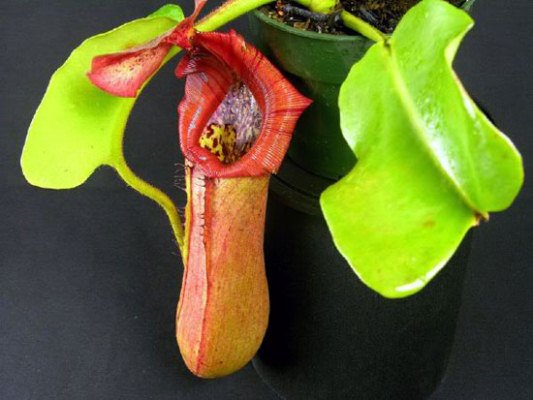Whether or not Man-Eating Tree?
Human carnivorous plants have long been an obsession for many people. Born, great biologist Charles Robert Darwin (1809-1882), the father of evolutionary theory spent 15 years studying the plants that can eat humans.
Is there a species of cannibalism in the world?

Charles Robert Darwin
From carnivorous plants
Unlike animals, plants can create their own food. They take carbon dioxide from the air, groundwater, photosynthesis from the sun. However, in addition to these, minerals are also essential for plant growth.
There are several plants that take minerals by becoming carnivorous plants - carnivorous plant. In Latin carnivorous means meat-eating. They do not take minerals from the soil but by trapping and eating animals. Most victims of carnivorous plants are insects . Plants take nutrients from those bad animals to continue to grow.
Carnivorous plants have many ways to trap animals . Pitcher plants have leaves that grow like a vase with a hat to open. Inside the vase are substances with a very sweet smell that appeal to insects. A small stalk that leads from the hat to the vial of the insect can crawl deep into the cap. However, the small stem and the vase were very smooth, causing the insects to crawl to fall down when slipping in, the mucus clinging to the wings made them unable to fly and did not crawl. And the mucus that lies at the bottom of the bottle will decompose the insect's body into food that will help the plant get more nutrients.
 Nepenthes
Nepenthes
The yellow trumpet is another way to lure animals. Inside the leaves of the golden lilies there is a sweet substance that makes insects very fond of but when eaten, they will be paralyzed and fall into the flower bottom and decompose into nutrients for the plant.
Sundries use the nectar to attract insects into the petals. The petal petals have a series of tiny hairs that are very sensitive to the stick around. When insects get in, those hairs will roll into the victim and the glue will make the insect unable to escape. Then the hairs will cover the glue around the insect, causing them to suffocate. The process of decomposing from the slime will turn the insect's body into a delicious meal for the pistil.
The most exotic carnivorous plant is probably the Venus flytrap whose scientific name is Dionaea muscipula . This species only grows in Carolina. The leaves are shaped like two bottle caps on each other with teeth bristling. Inside the leaves are two very sensitive hair strands. As long as the insect lands and touches these two hairs, the leaves immediately fall, making the insects unable to escape. Inside, the decomposing substance will erupt to kill the victim and turn them into nutrients for plants.

Tree Venus flytrap
To the cannibal tree
So are any carnivorous plants capable of eating humans? Actually the answer is no. The largest carnivorous plant is Nepenthes. It grows in Southeast Asia and measures up to 50 feet (15m). Nepenthes has the ability to trap large insects and even small animals such as mice and frogs. The decomposing substance of Nepenthes plants has a volume of up to 1 gallon. Farmers often plant Nepenthes trees around their rice fields to resist rice rodents eating rice.
There are no carnivorous plants big enough to eat people. So where does the legend of human carnivores come from?
The tree that caused rumors of human carnivores is the Amorphophallus titanum tree, which is often known by another name "corpse flower" . Amorphophallus titanum is the plant with the largest flower, has the strongest odor and looks quite ferocious. The flower of the Amorphophallus titanum tree can be up to 9 feet long and has a very unpleasant smell like the smell of rotting flesh being decomposed. The smell attracts bees and when the bee lands, the pollen will fall down the fence, causing the bee to not fly and fall to the flower bottom and decompose into the food of the plant.
 Species Amorphophallus titanum
Species Amorphophallus titanum
The species Amorphophallus titanum originates from Indonesia. Especially when carrying this tree to grow in other areas like the US, the tree does not bloom anymore. Only one tree Amorphophallus titanum blooms in 1937 at the New York Zoo. When the flowers bloom, the petals grow 4 inches (10cm) each day. Because of its large shape and rotting flesh, Amorphophallus titanum is sometimes considered a carnivorous plant.
The irony is that the tree is capable of "cannibalism " mentioned above not only can not eat anyone but is destroyed by humanity. The expansion of plant areas and cultivation of fruit trees has seriously threatened the survival of carnivorous plants.
In primeval forests there are some plants that emit scents that contain a variety of toxins, even causing coma. In the tropical forest, there exist many kinds of poisonous ants, poisonous spiders with a variety of varieties, these evil insects inherit the human habit of comatose to bite and burn, causing people to die. After the dead they will eat clean, these unfortunate cases often happen to the adventurers. Therefore human death is not caused by plants but by poisonous insects. But plants have helped one hand to make 'cannibalism' insects true.
- The oldest tree in England has changed sex after 3,000 years
- Ancient trees have unique and strange shapes all over the world
- Mysterious fir tree regenerates itself from the dead
- He deciphered the ash tree sequence
- Story about 'devil tree': Witness the massacre of 1 family and many other deaths
- In America there is an oak tree
- The 10 most exotic plants on Earth
- The oldest 9550-year-old tree from the Ice Age
- Why is there a tradition of decorating and lighting up Christmas trees?
- Highest tree species - Almond Tree Eucalyptus amygdalina
- 4,000-year-old tree in England is dying
- The secret of the oldest tree in the world is still alive
 Why do potatoes have eyes?
Why do potatoes have eyes? 'Tragedy' the world's largest carnivorous life: Death becomes ... public toilet
'Tragedy' the world's largest carnivorous life: Death becomes ... public toilet Tomatoes were once considered 'poisonous' for 200 years
Tomatoes were once considered 'poisonous' for 200 years Detecting microscopic parasites on human face
Detecting microscopic parasites on human face